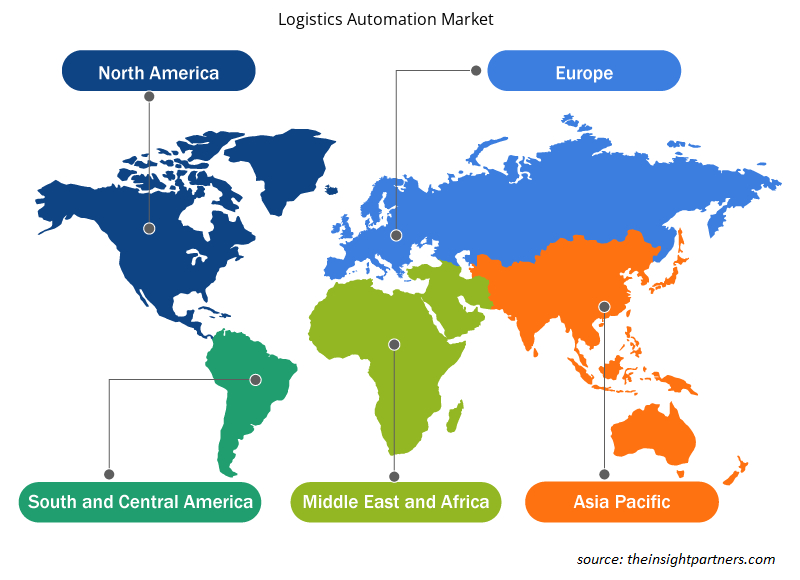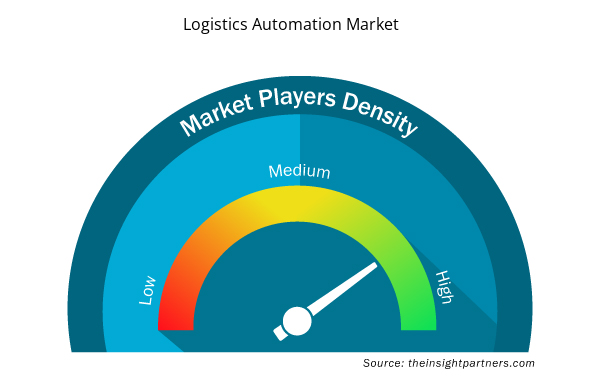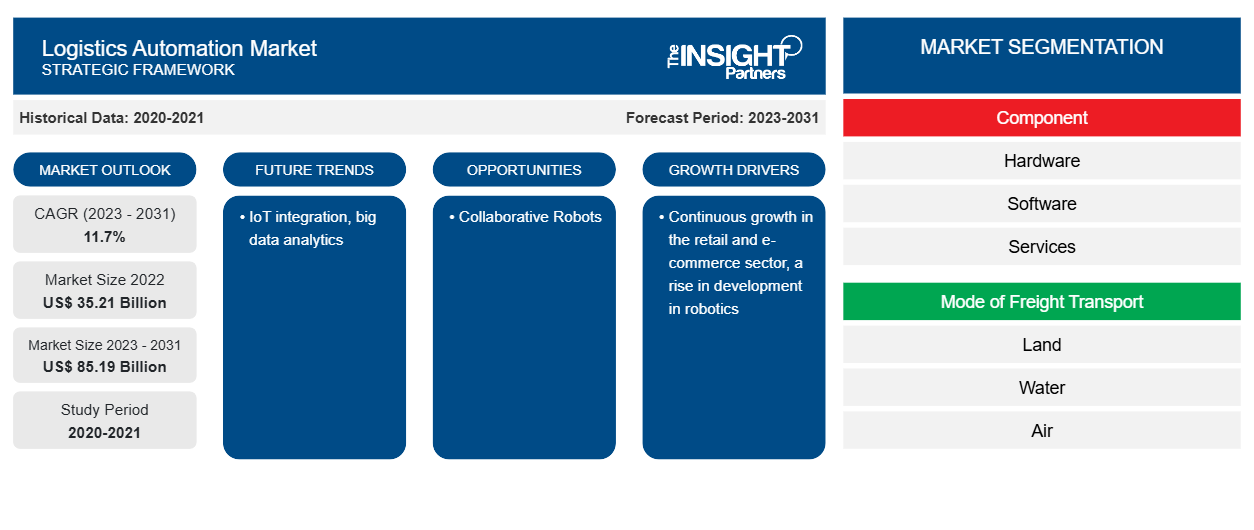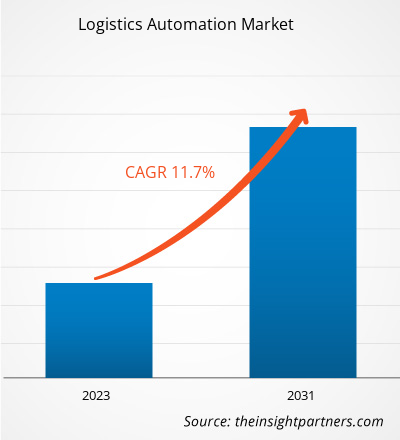物流自動化市場規模は、2022年の352億1,000万米ドルから2030年には851億9,000万米ドルに達すると予測されています。市場は2022年から2030年の間に11.7%のCAGRを記録すると予想されています。IoT統合とビッグデータ分析は、今後も市場の主要なトレンドであり続けると思われます。
物流自動化市場分析
消費者の期待が高まる中、市場プレーヤーは倉庫のITと運用機能への投資に注力しています。テクノロジー企業が仕分けから配置まですべてを行うため、世界的に接続技術の開発が進んでいます。最新のサプライチェーン技術とモノのインターネット(IoT)を活用しています。スマート倉庫は、サプライチェーンプロセスの効率と速度を向上させるハブとして機能します。作業員のウェアラブルからセンサーやスマート機器まで、インターネット対応のデバイスとテクノロジーは、物流管理を大きく変えることができます。倉庫と輸送管理では、サプライチェーン全体で商品の保管と移動を自動化する物流自動化ロボットを積極的に採用しています。物流自動化ロボットは、倉庫と保管施設全体に統合され、製品を整理して輸送します。これらのロボットは、手作業に比べて稼働率も向上し、業界の生産性と収益性の向上につながります。物流ロボットの主な用途は、保管施設や倉庫に配備され、商品を輸送するモバイル無人搬送車( AGV)です。倉庫内のさまざまなパレットに製品を出荷および保管するために、事前に定義された経路で動作します。AGV は、全体的な物流コストを削減し、サプライ チェーンを効率的に合理化するのに役立ちます。そのため、倉庫でのロボットの利用の増加は、今後数年間の物流自動化市場の予測に大きな影響を与える可能性があります。
物流自動化市場の概要
物流自動化市場では、倉庫やヤードなどの厳密に管理された環境での自動運転車の導入が増えており、近年、物流ビジネスにおける自動運転車の重要性が高まっています。しかし、高速道路や市街地などの共有の公共の場所に自動運転車を配備することは、物流業務の最適化と安全性の向上に向けた業界の次の大きな一歩となる可能性があります。AI の技術開発の拡大、およびセンサーや視覚技術の開発への多額の投資の増加は、自動運転車の実現に役立ちます。自動運転車とドローンは、自動物流システムの重要なコンポーネントです。たとえば、Google と Tesla は、無人運転車の技術を大幅に進歩させています。レーダー技術とコンピューターのパワーが大幅に進歩したため、自動運転は過去 20 年間で SF から非常に実現可能な可能性へと進化しました。ポータブル技術が十分に向上し、超軽量ハードウェアが自己改善アルゴリズムに基づいて決定を下せるようになったため、エンジニアは自動運転車で人間の意思決定を模倣できる可能性が高まっています。
要件に合わせてレポートをカスタマイズする
このレポートの一部、国レベルの分析、Excelデータパックなど、あらゆるレポートを無料でカスタマイズできます。また、スタートアップや大学向けのお得なオファーや割引もご利用いただけます。
- このレポートの主要な市場動向を入手してください。この無料サンプルには、市場動向から見積もりや予測に至るまでのデータ分析が含まれます。
物流自動化市場の推進要因と機会
小売および電子商取引部門の継続的な成長が市場を有利にする
物流自動化は、在庫、追跡、梱包、倉庫保管、出荷の問題を管理するための電子商取引の重要な要素の 1 つです。小売業と電子商取引では、企業はタイムリーな配送と返品ポリシーを守る責任があります。商品や製品を交換する必要がある場合、企業はリバース ロジスティクスのすべての操作を処理する必要があります。小売業と電子商取引のビジネスでは、物流自動化プロバイダーがアップグレードされたテクノロジー、拡張性、柔軟性、効率性を提供します。さらに、電子商取引セクターは成長しています。たとえば、インドでは 2020 年以降 1 億 2,500 万人のオンライン ショッピング ユーザーが増加しており、2025 年までにさらに 8,000 万人に達すると予想されています。
物流自動化ソフトウェア企業が小売業や電子商取引企業に提供する物流要件とサービスには、倉庫管理、サプライチェーン管理、統合サービス、注文処理などがあります。企業が物流自動化サービスプロバイダーを通じて物流要件をアウトソーシングすると、電子商取引に関連するいくつかの利点を実現できます。これにより、小売業と電子商取引の参加者は特定の役割を果たすことができます。物流自動化企業はサプライチェーン管理を専門としており、オンラインストアがマーケティングやその他のビジネスオペレーションを強化できるようにしています。物流自動化ソフトウェアを使用すると、倉庫管理者は複数行のアイテムの仕分け、分割ケースピッキング、パレット化などのさまざまなプロセスを効率的に処理できます。したがって、物流自動化ソフトウェアは、世界中の小売業と電子商取引部門で大きなチャンスを持っています。これにより、物流自動化市場の成長が促進されます。
協働ロボット
数多くのビジネス分野や業界プロセスにコボットが導入されて以来、物流および倉庫業界では生産性と効率性が大幅に向上し、さまざまなサービス プロバイダーが高まる需要に対応できるようになりました。コボット テクノロジーは進化しており、インダストリー 4.0 の出現により、サプライ チェーンの効率性と倉庫業界は引き続き恩恵を受けるでしょう。コボットは、倉庫や配送センターなどの特定の作業スペースで人間と連携するように構築および設計されているため、人間の負傷のリスクを軽減するのに役立つさまざまな機能を実行します。コボットは、人工知能 (AI) と機械学習テクノロジーを使用して適切かつ効率的に機能するように作成されています。
物流自動化市場レポートのセグメンテーション分析
物流自動化市場分析の導出に貢献した主要なセグメントは、コンポーネント、貨物輸送モード、アプリケーション、およびエンドユーザー産業です。
- コンポーネントに基づいて、物流自動化市場はハードウェア、ソフトウェア、サービスに分かれています。2022年にはハードウェアセグメントが最大のシェアを占めました。
- 貨物輸送のモード別に、市場は陸上、水上、航空に分割されています。
- アプリケーション別に見ると、市場は倉庫管理と輸送管理に分類されます。
- エンドユーザー業界別に見ると、市場は製造、小売および電子商取引、石油およびガス、食品および飲料、自動車、ヘルスケアおよび医薬品、その他に分類されます。
物流自動化市場シェアの地域別分析
物流自動化市場レポートの地理的範囲は、主に北米、アジア太平洋、ヨーロッパ、中東およびアフリカ、南米および中米の 5 つの地域に分かれています。
アジア太平洋地域は、2022年に物流自動化市場で最も急速に成長する地域です。アジア太平洋地域は経済成長を遂げており、小売・電子商取引、製造、石油・ガス、食品・飲料、自動車、ヘルスケアなど、さまざまな分野で成長が見込まれています。地域全体で先進的で革新的な技術の採用率が高くなっています。アジア諸国では、小売・電子商取引業界の発展に向けた政府による投資やさまざまな取り組みにより、物流自動化ソリューションの導入が年々増加しています。
この地域には強力な電子商取引産業があります。この地域にある倉庫は最先端の技術を実装しています。また、サプライヤーからの製品数の増加により、倉庫管理は体系的で実行可能な操作のためにロボット工学と物流自動化ソフトウェアを採用するよう促されています。アジア諸国の新興市場は、市場競争の激化、コスト圧力、インフレの引き金、市場の変動などの課題に直面しています。そのため、サプライチェーンの計画と実行は複雑になります。これらの問題に対処するために、メーカーとサプライヤーは、可視性を向上させ、 在庫管理 プロセスを強化することで、アウトバウンドとインバウンドのサプライチェーンの制御を最大限に高める物流自動化サービスに熱心に期待しています。
物流自動化市場の地域別分析
予測期間を通じて物流自動化市場に影響を与える地域的な傾向と要因は、Insight Partners のアナリストによって徹底的に説明されています。このセクションでは、北米、ヨーロッパ、アジア太平洋、中東、アフリカ、南米、中米にわたる物流自動化市場のセグメントと地理についても説明します。

- 物流自動化市場の地域別データを入手
物流自動化市場レポートの範囲
| レポート属性 | 詳細 |
|---|---|
| 2022年の市場規模 | 352億1千万米ドル |
| 2030年までの市場規模 | 851億9000万米ドル |
| 世界のCAGR(2023年~2031年) | 11.7% |
| 履歴データ | 2020-2021 |
| 予測期間 | 2023-2031 |
| 対象セグメント | コンポーネント別
|
| 対象地域と国 | 北米
|
| 市場リーダーと主要企業プロフィール |
|
市場プレーヤーの密度:ビジネスダイナミクスへの影響を理解する
物流自動化市場は、消費者の嗜好の変化、技術の進歩、製品の利点に対する認識の高まりなどの要因により、エンドユーザーの需要が高まり、急速に成長しています。需要が高まるにつれて、企業は提供を拡大し、消費者のニーズを満たすために革新し、新たなトレンドを活用し、市場の成長をさらに促進しています。
市場プレーヤー密度とは、特定の市場または業界内で活動している企業または会社の分布を指します。これは、特定の市場スペースに、その規模または総市場価値と比較して、どれだけの競合相手 (市場プレーヤー) が存在するかを示します。
物流自動化市場で事業を展開している主要企業は次のとおりです。
- ビューマーグループ
- 株式会社ダイフク
- ナップAG
- メカルクス、SA
- デマティック(KIONグループ)
- 村田機械株式会社
免責事項:上記の企業は、特定の順序でランク付けされていません。

- 物流自動化市場のトップキープレーヤーの概要を入手
物流自動化市場のニュースと最近の動向
物流自動化市場は、主要な企業出版物、協会データ、データベースなどの一次調査と二次調査を経て定性的および定量的データを収集することで評価されます。以下に、物流自動化市場の動向をいくつか示します。
- オムロンは、シンガポール、東南アジア、オセアニアの顧客基盤に対応するため、シンガポールに初の物流オートメーションセンターを開設すると発表しました。(出典:オムロン、プレスリリース、2022年12月)
- FM Logistic はインドに 5 番目のマルチ顧客施設(そして初の自社所有施設)を開設しました。(出典:FM Logistic、プレスリリース、2022 年 5 月)
物流自動化市場レポートの対象範囲と成果物
「物流自動化市場規模と予測(2020〜2030年)」レポートでは、以下の分野をカバーする市場の詳細な分析を提供しています。
- 対象範囲に含まれるすべての主要市場セグメントについて、世界、地域、国レベルでの物流自動化市場規模と予測
- 物流自動化市場の動向、および推進要因、制約、主要な機会などの市場動向
- 詳細なPEST/ポーターの5つの力とSWOT分析
- 主要な市場動向、世界および地域の枠組み、主要プレーヤー、規制、最近の市場動向を網羅した物流自動化市場分析
- 物流自動化市場の市場集中、ヒートマップ分析、主要プレーヤー、最近の動向を網羅した業界の状況と競争分析
- 詳細な企業プロフィール
- 過去2年間の分析、基準年、CAGRによる予測(7年間)
- PEST分析とSWOT分析
- 市場規模価値/数量 - 世界、地域、国
- 業界と競争環境
- Excel データセット



Report Coverage
Revenue forecast, Company Analysis, Industry landscape, Growth factors, and Trends

Segment Covered
This text is related
to segments covered.

Regional Scope
North America, Europe, Asia Pacific, Middle East & Africa, South & Central America

Country Scope
This text is related
to country scope.
よくある質問
The logistics automation market size is projected to reach US$ 85.19 billion by 2030
The logistics automation market is expected to register a CAGR of 11.7% during 2022–2030
Beumer Group, Daifuku Co., Ltd., KNAPP AG, Mecalux, S.A., Dematic (KION Group), Murata Machinery, Ltd., TGW Logistics Group, Swisslog Holding AG, and Toshiba Infrastructure Systems and Solutions Corp are among the leading payers operating in the logistics automation market.
IoT integration and big data analytics are likely to remain key trends in the market.
North America dominated the logistics automation market in 2022.
Continuous growth in the retail and e-commerce sector and a rise in development in robotics are expected to drive the logistics automation market.
Trends and growth analysis reports related to Electronics and Semiconductor : READ MORE..
The List of Companies - Logistics Automation Market
- Honeywell International Inc.
- Beumer Group
- Daifuku Co., Ltd.
- KNAPP AG
- Mecalux, S.A.
- Dematic (KION Group)
- Murata Machinery, Ltd.
- TGW Logistics Group
- Swisslog Holding AG
- VITRONIC
The Insight Partners performs research in 4 major stages: Data Collection & Secondary Research, Primary Research, Data Analysis and Data Triangulation & Final Review.
- Data Collection and Secondary Research:
As a market research and consulting firm operating from a decade, we have published and advised several client across the globe. First step for any study will start with an assessment of currently available data and insights from existing reports. Further, historical and current market information is collected from Investor Presentations, Annual Reports, SEC Filings, etc., and other information related to company’s performance and market positioning are gathered from Paid Databases (Factiva, Hoovers, and Reuters) and various other publications available in public domain.
Several associations trade associates, technical forums, institutes, societies and organization are accessed to gain technical as well as market related insights through their publications such as research papers, blogs and press releases related to the studies are referred to get cues about the market. Further, white papers, journals, magazines, and other news articles published in last 3 years are scrutinized and analyzed to understand the current market trends.
- Primary Research:
The primarily interview analysis comprise of data obtained from industry participants interview and answers to survey questions gathered by in-house primary team.
For primary research, interviews are conducted with industry experts/CEOs/Marketing Managers/VPs/Subject Matter Experts from both demand and supply side to get a 360-degree view of the market. The primary team conducts several interviews based on the complexity of the markets to understand the various market trends and dynamics which makes research more credible and precise.
A typical research interview fulfils the following functions:
- Provides first-hand information on the market size, market trends, growth trends, competitive landscape, and outlook
- Validates and strengthens in-house secondary research findings
- Develops the analysis team’s expertise and market understanding
Primary research involves email interactions and telephone interviews for each market, category, segment, and sub-segment across geographies. The participants who typically take part in such a process include, but are not limited to:
- Industry participants: VPs, business development managers, market intelligence managers and national sales managers
- Outside experts: Valuation experts, research analysts and key opinion leaders specializing in the electronics and semiconductor industry.
Below is the breakup of our primary respondents by company, designation, and region:

Once we receive the confirmation from primary research sources or primary respondents, we finalize the base year market estimation and forecast the data as per the macroeconomic and microeconomic factors assessed during data collection.
- Data Analysis:
Once data is validated through both secondary as well as primary respondents, we finalize the market estimations by hypothesis formulation and factor analysis at regional and country level.
- Macro-Economic Factor Analysis:
We analyse macroeconomic indicators such the gross domestic product (GDP), increase in the demand for goods and services across industries, technological advancement, regional economic growth, governmental policies, the influence of COVID-19, PEST analysis, and other aspects. This analysis aids in setting benchmarks for various nations/regions and approximating market splits. Additionally, the general trend of the aforementioned components aid in determining the market's development possibilities.
- Country Level Data:
Various factors that are especially aligned to the country are taken into account to determine the market size for a certain area and country, including the presence of vendors, such as headquarters and offices, the country's GDP, demand patterns, and industry growth. To comprehend the market dynamics for the nation, a number of growth variables, inhibitors, application areas, and current market trends are researched. The aforementioned elements aid in determining the country's overall market's growth potential.
- Company Profile:
The “Table of Contents” is formulated by listing and analyzing more than 25 - 30 companies operating in the market ecosystem across geographies. However, we profile only 10 companies as a standard practice in our syndicate reports. These 10 companies comprise leading, emerging, and regional players. Nonetheless, our analysis is not restricted to the 10 listed companies, we also analyze other companies present in the market to develop a holistic view and understand the prevailing trends. The “Company Profiles” section in the report covers key facts, business description, products & services, financial information, SWOT analysis, and key developments. The financial information presented is extracted from the annual reports and official documents of the publicly listed companies. Upon collecting the information for the sections of respective companies, we verify them via various primary sources and then compile the data in respective company profiles. The company level information helps us in deriving the base number as well as in forecasting the market size.
- Developing Base Number:
Aggregation of sales statistics (2020-2022) and macro-economic factor, and other secondary and primary research insights are utilized to arrive at base number and related market shares for 2022. The data gaps are identified in this step and relevant market data is analyzed, collected from paid primary interviews or databases. On finalizing the base year market size, forecasts are developed on the basis of macro-economic, industry and market growth factors and company level analysis.
- Data Triangulation and Final Review:
The market findings and base year market size calculations are validated from supply as well as demand side. Demand side validations are based on macro-economic factor analysis and benchmarks for respective regions and countries. In case of supply side validations, revenues of major companies are estimated (in case not available) based on industry benchmark, approximate number of employees, product portfolio, and primary interviews revenues are gathered. Further revenue from target product/service segment is assessed to avoid overshooting of market statistics. In case of heavy deviations between supply and demand side values, all thes steps are repeated to achieve synchronization.
We follow an iterative model, wherein we share our research findings with Subject Matter Experts (SME’s) and Key Opinion Leaders (KOLs) until consensus view of the market is not formulated – this model negates any drastic deviation in the opinions of experts. Only validated and universally acceptable research findings are quoted in our reports.
We have important check points that we use to validate our research findings – which we call – data triangulation, where we validate the information, we generate from secondary sources with primary interviews and then we re-validate with our internal data bases and Subject matter experts. This comprehensive model enables us to deliver high quality, reliable data in shortest possible time.


 このレポートの無料サンプルを入手する
このレポートの無料サンプルを入手する